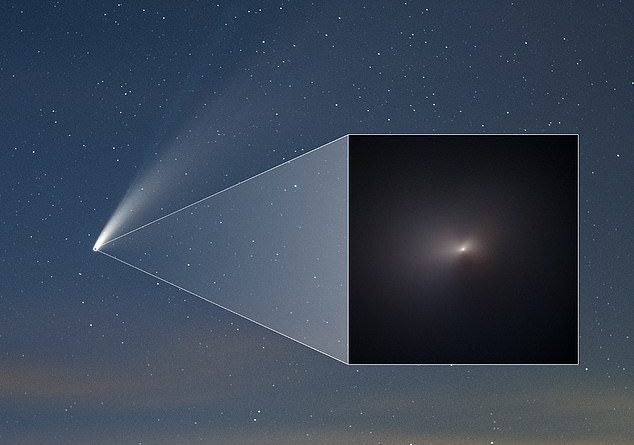Hubble telescope captures close-up image of comet Neowise after its journey around the Sun
[ad_1]
Hubble telescope captures close-up image of comet Neowise after its journey around the Sun showing its solid nucleus has remained intact
- Neowise is the brightest comet visible in the northern skies since Hale-Bopp
- It passed closest to the Sun — at 27 million miles’ distance — on July 3, 2020
- NASA have now released shots of Neowise and its jets taken a month later
- They reveal that the solar heat and gravitational forces did not split its core apart
- Analysis of the jets of dust and gas may reveal more about the early solar system
NASA has released a stunning close-up image of comet Neowise following its journey around the Sun — revealing that its solid core has remained intact.
The shots were captured by the Hubble Space Telescope on August 8, 2020, and show the shell of gas and dust surrounding the icy body’s central nucleus.
Neowise is the brightest comet to have been visible from the northern hemisphere since Hale-Bopp back in 1997.
This is the first time that Hubble has photographed a comet of this brightness at such a resolution following a close pass of the Sun.
Having passed the Sun, Neowise is now heading back further out into space at around 144,000 miles per hour — not to return for some 7,000 years.

NASA has released a stunning close-up image of comet Neowise (pictured, inset) following its journey around the Sun — one that reveals that its solid core has remained intact. Pictured, main — Neowise and its two tails of dust and gas as seen from the Earth on July 16, 2020
‘Hubble has far better resolution than we can get with any other telescope of this comet,’ said lead researcher and astronomer Qicheng Zhang of the California Institute of Technology.
‘That resolution is very key for seeing details very close to the nucleus.’
‘It lets us see changes in the dust right after it’s stripped from that nucleus due to solar heat, sampling dust as close to the original properties of the comet as possible,’ Mr Zhang added.
Comet Neowise was first spotted by — and named after — NASA’s Near-Earth Object Wide-field Infrared Survey Explorer (NEOWISE) space telescope in March 2020.
The icy body then became visible from the Earth’s surface from the northern hemisphere for a short while in the summer as its proximity to the Sun caused it to melt, unleashing tails of dust and gas behind it.
In a similar fashion, Neowise’s icy core nucleus is too small — at less than three miles (4.8 kilometres) in diameter — for Hubble to see on its own.
Instead, the image capture by the space telescope shows the comet’s so-called ‘coma’, a vast nebulous envelope of gas and dust surrounding the core which astronomers have determined to be some 11,000 miles (18,000 km) across.

The shots were captured by the Hubble Space Telescope, pictured here above the Earth, on August 8, 2020, and show the shell of gas and dust surrounding the icy body’s central nucleus

This is the first time that Hubble has photographed a comet of this brightness at such a resolution (pictured) following a close pass of the Sun. Having passed the Sun, Neowise is now heading out into space at around 144,000 miles per hour — not to return for some 7,000 years
Neowise was closest to the Sun on July 3, 2020 — when its flyby brought it within 27 million miles (43 million kilometres) of our star.
In such close encounters, thermal and gravitational stresses can often cause comets to fragment into smaller pieces — but analysis of the Hubble images suggest that Neowise’s nucleus has remained in one piece.
The shots also reveal the two curving jets of dust and gas being released from the comet in opposite directions as the ice on the surface rapidly ‘melts’ directly from a solid into a gas.
Analysis of the colour of these jets — and how they change as Neowise moves further away from the Sun’s influence — may help astronomers understand how solar heat impacts the composition and structure of the dust.
In turn, thus will help indicate the likely original composition of the comet’s components — shining light on the nature of the early solar system in which Neowise would have formed.
[ad_2]
Source link



